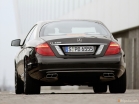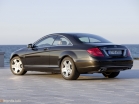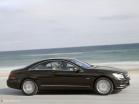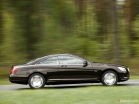Test drive Mercedes Benz CL class since 2010 compartment
Three stars
 In the painting, architecture and music of our days, mixing different styles is a common occurrence. Car designers are also not alien to experiments. What it turns out from this could be seen in Vienna, where Mercedes-Benz showed his compartment. Cars with a three -beam star, and even with this type of body, is always an occasion to appear in all its glory. The test races began with a small (by Mercedes standards, of course) the CLC city coupe, continued on the alleged four-door CLS coupe and ended with the top version of CL, which was added to all other delights 4Matic.
In the painting, architecture and music of our days, mixing different styles is a common occurrence. Car designers are also not alien to experiments. What it turns out from this could be seen in Vienna, where Mercedes-Benz showed his compartment. Cars with a three -beam star, and even with this type of body, is always an occasion to appear in all its glory. The test races began with a small (by Mercedes standards, of course) the CLC city coupe, continued on the alleged four-door CLS coupe and ended with the top version of CL, which was added to all other delights 4Matic. The shortest
Today in Europe small light cars are in fashion. And even such a Grand as Mercedes offers the consumer a compact CLC based on a handsome C-class. Although a small compartment attracts attention, it can be said about it: beautiful, but not slim. Front, undoubtedly, the luck of designers. But the cut tail, no matter how disguise with lighting equipment, still looks stopped. Although the masking efforts are able to give rise to the feeling that this is not just a modification, and even on the platform of the previous C-class, but a fundamentally new model. And here marketers come to the aid of designers. They know for sure that the buyer of such a car really wants to look extremely successful and is therefore ready to close his eyes to a lot, with the exception of two main parameters: firstly, he has a real Mercedes, and secondly, he has a real compartment. To join a large family of car owners with a three -beam star, this is enough. Moreover, a beautiful note remains for life: my first car was a compartment from Mercedes. Only Richard Gir in the film Beauty at that first machine was a limousine was stronger. But for that and movie
And here Mercedes-Benz CLC 200 Kompressor with a 184-horsepower four equipped with a mechanical supercharger. Compared to the usual CLC C-class, it has not changed much inside. Although there were a lot of cut off from behind, this did not affect the size of the salon. Everything was reflected only on the volume of the trunk.
This car rides with a pressed (or cut off?) Tail is very briskly. Which is completely logical. After all, not a single Doberman is burdened by the whole life committed over him in infancy shortening and acts in full accordance with the purpose and parameters of the breed. So the CLC 200 Kompressor coupe rides beautifully at good speeds, without frightening others and not shaking the contents. For the role of a real compartment from Mercedes, it is quite suitable.
The strangest thing
Having released a strange four -door compartment of Mercedes Benz CLS on the market, German marketers guessed. And no matter how many journalists break the feathers, this car with enlarged front doors and a sloping roof fell in love with the owners. Popularity is evidenced by the fact that our CLS has received his nickname: now it is the humpbacked. For the test of three compartment, the company put up this car to boast of skillful restyling to reporters. Outside there are almost no changes, but inside the car has become buried. Almost new interior, remarkably inscribed in the general appearance. It turned out very harmoniously.
The huge front door opens widely, but demands to politely bow to the driver. A fairly light half -column, and the machine allows you to sit on the seat. Around nothing covered luxury. A huge dashboard sheathed with skin and trimmed with a natural walnut tree. Stylish three -spoke steering wheel. Everything returns to the atmosphere of large Mercedes coupe of the 50s. The governing bodies are understandable and made with concise minimalism, not a single extra button. The door panels deserve special mention. They are sheathed soft, pleasant to the touch with skin, and the bend of the armrest insists to put his hand on him. The controls of the seat, mirrors and glass windows are also made here. At the back there are two individual chairs separated by a wide console. Unlike other compartment there is spacious and free. Although, unlike all the other compartment in the world and doors, there is more permissible.
Engine starting. But it seems that nothing happens. At idle, the V-shaped five-liter eight (with a capacity of 388 hp) is quiet and balanced, like a summer night. By pressing the gas, you are pleasantly amazed at the sensitivity of the pedal. And they say that the electronic pedals are always sorted by the gears of the 7-speed automatic shifts easily and clearly. The car instantly gains speed. The engine, as if by a slanting, begins to make a characteristic thoroughbred sound, and I want to go faster. The car provides a lot of capabilities for this, and if you go correctly, keep the trajectory, then the electronics will not intervene, believing the driver’s skill. Although it will not cease to suspect a person of unrighteous intentions and will react immediately to errors in piloting, reducing momentum, and if necessary, then slowing down. The effectiveness of the brakes is beyond praise, and can it be otherwise? The suspension is moderately tough, but not enough to cause reproaches. In terms of controllability, stability and dynamic characteristics, Mercedes Benz CLS will arrange almost all of its rivals. The appearance is excellent. A large trunk and a convenient entrance to the rear places make it practical. CLS car for the driver. Of all the possible four people, it is the driver who will be most interesting to the driver, and the most impressions will only be addressed to him alone. The rest will only be delivered in comfort and in a beautiful interior. It is a pity that the test drive ends so quickly. I would drive and drive without getting out of the steering wheel of this wonderful car.
The most correct one
The large Mercedes 500 CL 4Matic coupe is the real of all cars named Mercedes. It causes a special condition that can be called the departure into another dimension. It seems that the cargo of everyday fuss has gone out of the unknown where and all the problems were solved by themselves. A light restyling added the necessary severity in a skillful combination of swift lines, sharp faces and rounded shapes, emphasizing the Mercedes image of a graceful, elegant and always recognizable image. At the wheel of this large compartment, you can slowly roll along the streets, demonstrating to others and yourself.
Being inside the most important Mercedes compartment, you plunge into a parallel world; All unnecessary, all noise and vanity remain there, behind multi -layer glasses. Inside the abundance of expensive materials. Seats, doors, visors of the instrument panel, tunnel cladding everything is lined with light genuine skin, and the ceiling and racks are very pleasant to the touch dark alcantara. You feel so much with this high -quality luxury that even inappropriate wooden inserts on the steering wheel are not annoying. It seems that the designers studied Feng Shui for many years before creating a new concept. The inner world of this Mercedes is excellently relaxed and thought out so as not only to reassure, but also to keep in a state of peace as long as possible. What is a large extent is facilitated by supercomforting front seats with a massager and ventilation, adjustable in all directions, and the absence of a pedestal of buttons on the central console. If it were not for the disgrace with steering wheel switches. There were three of them. The main, completely uncomfortable, overloaded with functions beyond measure and beyond logic, and even two miserable on the puny legs. They are suitable only for those who love Mercedes recklessly. The rest, especially at the stage of addiction, will suffer due to their complete inconsistency of the concept of Feng Shui.
In a two -door car, the gallery is not intended for adults. Children, of course, can easily be able to accommodate on profiled seats, but all the time they will envy parents. And dad at this time will fight the steering wheel, refusing to return to a neutral position. Although, if you think about it, this is also a tribute to traditions, and it is unlikely that engineers working in the design bureau will easily refuse them.
Under the baritone of the V-shaped eight with a capacity of 388 hp Mercedes 500 CL 4MATIC flies around 100 km, like a courier train of a provincial half -house. A seven -speed automatic upon reaching 6500 rpm smoothly switches to the next step. The motor sings softly, the seats nullify the remarkable overload. The speed, meanwhile, exceeds 200 km/h. Eyes refuse to believe the speedometer. It seems that you are going much slower.
But you can still go to sports regime. The air suspension will become a little tougher. The steering wheel is more transparent. Hands will feel the profile of the road, the box will begin to actively use reduced gears. Naturally, the 2-ton compartment is not transformed into a sports car, however, in the management of a five-meter machine, the aerobatics will partially give way to an active drive. Having strengthened the stabilization system, you can even go through a turn in a shallow, but spectacular drift. Electronics will be on the alert and immediately stops the excessive dashing. Well, what about all -wheel drive? On dry asphalt paths, there was simply nowhere to try it.
EXCURSION
At first, the compartment was a machine created for two. True, provided that the driver sitting on the irrigation was not taken into account. A model of the first compartment can be considered Benz Mylord in 1901. He was still similar to a cart, in which they forgot to harness the horse, but became the progenitor of the so -called city coupe.
The icons of the style, that is, the cars that ascended the compartment to the top of the tables of ranks were created mainly in the 30s. One of them is the legendary Mercedes-Benz 540k Autobahnkurier 1939. In 2008, this model won the elegance contest at Villa de Este. Not because her beauty reached people for so long. And because she was once again dedicated to her, confirming the right to be called the classic of the genre.
In 1951, an expressive Mercedes-Benz 300 S Coupe was presented at the Paris Auto Show. He was called a car for the world elite. The car was very successful. It was from her that the tradition of making a compartment on the basis of large sedans went from her. The car turned out to be large and elegant, in addition powerful (the engine developed 150 hp) and fast, it accelerated to 175 km per hour. The Americans liked the car. Especially Hollywood stars, such a car owned Harry Cooper. In 1955, the coupe was modernized. An injection motor appeared, power increased to 175 hp. The abundance of chrome, skin and wood, the pretentiousness of forms were regarded by contemporaries as the highest achievement of design. All this was reflected at a price of 35,000 marks. It was very expensive. Therefore, for 7 years of production, only 314 cars were made. Today this model is the subject of the desire of many collectors of the world.
In October 1956, a new Mercedes-Benz 220 S Coupe model appeared with a in-line 100-horsepower six and a Hydrak system automatic clutch (costing 4500 DM). This model received the nickname Ponton. The car was the first Mercedes-Benz with non-current front and rear wings and without footsteps between them, which at that time was perceived as design innovation. The compartment had new pendants, and the brakes, although drum, but very powerful, Turbo-Finned systems. Mercedes-Benz 220 S Coupe was offered under the slogan more luxury for the same money: the front panel made of polished wood of rare species, leather, chromium and a heating and ventilation system, and simply the stove. The Ponton W180 coupe demonstrated a new level of technology and quality, achieved by the company by the end of the 50s. In November 1960, the latest compartment, and this was a version of the W128 with a 120-horsepower injection engine, left the assembly line. Many 2081 cars were made, of which 830 with injection.
Mercedes-Benz 280 Se Coupe was produced from 1961 to 1971. Like other vehicles of the W111 family, this compartment now makes the impression of a not very obsolete car, a kind of timeless design. The coupe could please four adults even when traveling over long distances. It was on this machine that Mercedes had crushed safety zones, a hard body of the body and three -point belts. As an option, an air conditioner was proposed. This was the first passenger car of the company with disk front brakes. In 1962, 300 SE appeared with an engine of 170 hp, with a 4-speed automatic and disk brakes on all wheels, with a power steering and air suspension. In total, 28,918 pieces were made in different modifications. And today such a car is considered the best model for a beginner collector.
Mercedes-Benz 250 C appeared in January 1968. Called Stroke 8, he is known to all experts in the brand. The compartment received a very spectacular flowing roof line. Since the car appeared in a difficult time of the oil crisis, they decided to save on it, leaving many common details with a sedan, which made it possible to seriously reduce the price.
Despite two doors, the car made it easy to penetrate the back seat. The side glasses without the framework were completely lowered (both door and rear side), and due to the absence of the central rack, the visual lightness of the silhouette was created, as if it were a convertible with a raised top. The engine is in a row six, starting with a carburetor 250 s and up to 250 CE with an injection with a capacity of 150 hp. This was the first Mercedes-Benz with an electronic injection of Bosch D Jetronik, so the engine has become economical, environmentally friendly and more reliable. In 1972, 280 s appeared with an engine of 160 and 185 hp. With him, the car accelerated to fantastic for its time 200 km per hour, that is, it was a real compartment for autobahns. One of the features of this car layered into the sleeping places of the seat. Until 1976, such cars produced 67,048 pieces.
Mercedes-Benz 560 SEC is a stylistically the cleanest compartment of its time, and thanks to the motor, the most powerful. Engineers used the S-class platform, shortening it by 85 mm, which did not at all prevent the coupe from being full-size four-seater. The top of the gamut was a model with a 5.6 liter V8 and a capacity of 172 hp. The premiere of the model took place at the Frankfurt Auto Show in 1981. At that time, the C126 family was very successful in the market, and buyers took a compartment at its base perfectly. In addition, they were pleased with such attractive trifles as electrical adjustment of seat belts, which allowed them to easily fit them under any figure, or, for example, door handles of a special shape protected from dirt. And for the first time as an option, a pillow for a driver was offered. The production of the model ended in 1991. Released 74 060 pieces.
A coupe based on a successful W124 model was made according to a classic recipe. The length was reduced by 85 mm and reduced a height by 36 mm. And although the coupe is built on the basis of the E-class, the internal content is borrowed from the S-class. There was no such comfort in the Mercedes-Benz compartment yet. First, 230 CE with a 4-cylinder engine with a capacity of 132 hp left the conveyor. and 300 sees with a six -capacity of 180 hp and triple catalyst. In 1988, ABS was included in standard equipment. In 1993, the model underwent restyling and received new engines. The superman E63 AMG was also made. Such cars were built very little and sold in the USA. The W124 compartment from 1987 to 1996 broke the production record for them released 141,498.
In 1992, a large Mercedes-Benz CL600 compartment appeared on the basis of the famous six hundredth in Russia. Motors were offered only V8 and V12. The compartment had its own grate, its headlights and a completely different back. The factory designation changed twice. In the first year, W140 appeared as 500 Sec and 600 SEC. He became the first compartment with a 12-cylinder engine with a capacity of 394 hp. In 1993, cars changed. They began to be called the S500 and S600 coupe. And in 1996, it got the name CL usual today. In addition to the new name, it appeared in it parking sensors, side safety curtains, a front passenger weight detector and xenon headlights. In 1995, this compartment for the first time in the world received a system of electronic stabilization. Production was completed in September 1998, making 26,022 cars.
Alexander Pikulenko
Source: MKOMBILA magazine [May/2008]






